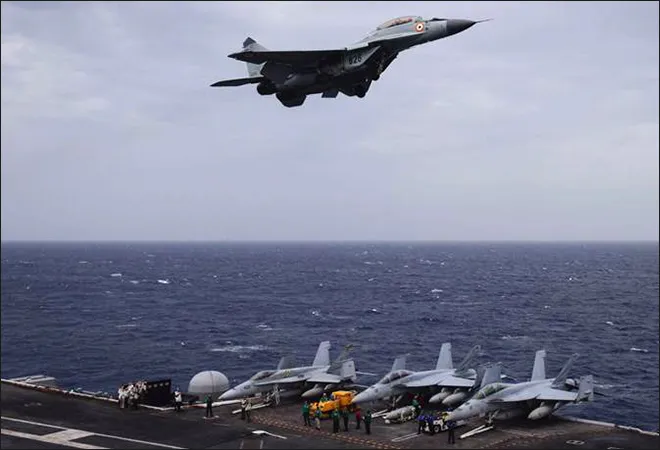-
CENTRES
Progammes & Centres
Location
What the US gets wrong – and India gets right – about the Indo-Pacific

Last month’s Shangri-La Dialogue made clear that the ‘Indo-Pacific’ – a coherent maritime system linking nations in the Indian and Pacific Oceans – is fast becoming a defining geopolitical theatre of the 21st century, if for the only reason that a majority of the world’s population, trade routes and wealth will reside here.
More urgently, the region is caught in a tug of war between China’s disruptive leadership ambitions, exemplified by the Belt and Road Initiative (BRI), and a partnership of democracies who seek to preserve a ‘rules-based order’.
In the long term, the US, India and China will remain the most consequential, but not the only, actors in this region, given that they will be the world’s largesteconomic and military powers by 2050. And while India and the US share common interests in the region, their approaches to the Indo-Pacific are slightly divergent.
One difference is geographical: while India’s Indo-Pacific s from the “shores of Africa to that of Americas,” the US bookends Western India and the Western Pacific as its theatre of engagement.
The other is geopolitical: US Defense Secretary James Mattis was outspokenly critical of China’s “intimidation and coercion” in the region, while Indian Prime Minister Narendra Modi stated that India’s strategy is not “directed against any one country”.
The roots of these differences lie in Delhi and Washington’s divergent understandings of the region and the aspirations of those who reside in it. Delhi’s vision responds to an Indo-Pacific that is organic – one that arises from a shared desire by communities and markets in Asia, and to a lesser extent, Africa, to integrate, seek technology and finance, secure energy supplies, facilitate trade and investment, and build partnerships.
Washington’s Indo-Pacific, on the other hand, is borne from the insecurity that “China seeks to displace the United States” in the region. The economic, political and security logic of America’s strategy is guided entirely by this increasingly cold war mindset – a fact made amply clear by a preliminary reading of the 2017 National Security Strategy and the 2018 National Defense Strategy.
How countries recast regional mental maps matters: it signals diplomatic, commercial and security priorities. More importantly, it also matters why they recast them.
China undoubtedly figures prominently in debates in both Delhi and Washington. However, if the US maintains a zero-sum “geopolitical competition between free and repressive visions of the Indo-Pacific” as its guiding impetus, its vision is going to find few takers.
The reason is simple: China seeks to mould a new pattern of regional and global interdependence through the BRI – placing Beijing at the centre of transcontinental economic relationships.
Beijing’s investments in the Indo-Pacific all the way from ASEAN, to Sri Lanka and the Maldives, to Gwadar in Pakistan and Djibouti in East Africa – and states in the region are keen to tap into this financial pool to address development imperatives. Indeed, Singapore’s Prime Minister has already warned that the country is averse to choosing between “rival blocs” – a sentiment that most Indo-Pacific countries undoubtedly share.
China’s capacity to hard-wire influence in the region (including the South China Sea, which remains America’s most pressing concern) would be extremely limited if it could not capitalise on its economic leadership. Similarly, for a rules-based order to succeed, liberal democracies must first offer transparent, market-based finance solutions to developing countries and strengthen cooperation between regional institutions like the East Asia Summit and the Indian Ocean Rim Association.
America’s myopic geographical and geopolitical vision certainly does no such thing.
Following the Trump Administration’s withdrawal from the Trans-Pacific Partnership, the US has made no new economic commitments in Southeast Asia, let alone the broader Indian Ocean Region. And a confrontational US trade policy towards several Asian states – including India – only makes matters worse. As for the rechristened Indo-Pacific Command, time will hopefully show that the nomenclature reflects operational changes.
On the other hand, the first tangible signs of addressing the deficit in economic and diplomatic leadership have come from Asian powers, like India and Japan – whose mental maps are aligned. They have agreed to provide “high quality” infrastructure investments (a moniker for non-predatory and sustainable finance) in India’s Northeast region to integrate with Southeast Asia, and have made similar commitments for Indian Ocean and Africa littorals as well through the Asia-Africa Growth Corridor.
Still, sceptics have argued that India’s less-than-confrontational approach to China at Shangri-La was part of a post-Wuhan reconciliation between the two Asian giants – an opinion that was bolstered by Delhi’s unwillingness to invite Australia, a partner Quadrilateral Initiative country, to the annual Malabar exercise.
This reading of events misinterprets India’s long-term approach to China, the Quad and the Indo-Pacific. When Modi said that the Indo-Pacific was “not directed against any one country,” he was not signalling hesitation to confront China. Rather, he was reaffirming India’s preferred governance architecture: multipolarity with multilateralism.
In this framework, China is a de-facto stakeholder, remaining an indispensable actor in conversations ning connectivity, sustainable development, and security. Simultaneously, however, Delhi will support flexible alignments of states to maintain a balance of power in the region, so long as they subscribe to the norms of a rules-based order.
The Quad (which, irrespective of bilateral hiccups, has met twice now) is only one such alignment – consider for example, that India is also cooperating with France in the West Indian Ocean, while the United Kingdom will participate in Freedom of Navigation Operations in the South China Sea along with the US.
To sustain a long-term India-US partnership in the Indo-Pacific, America must accept, as India already has, that a multipolar region will require inclusive, not zero-sum, governance solutions.
The US would do well to bear in mind that one of the earliest shared visions for Indo-Pacific cooperation outside the Quad was signed between India and Indonesia. This was as much a referendum on India’s choices, as it was a clear signal that multiple narratives will shape the Indo-Pacific.
This commentary originally appeared in Asia & the Pacific Policy Society.
The views expressed above belong to the author(s). ORF research and analyses now available on Telegram! Click here to access our curated content — blogs, longforms and interviews.

Akhil Deo was Junior Fellow at ORF. His interests include urban governance sustainable development civil liberties cyber governance and the impact of future technologies on ...
Read More +